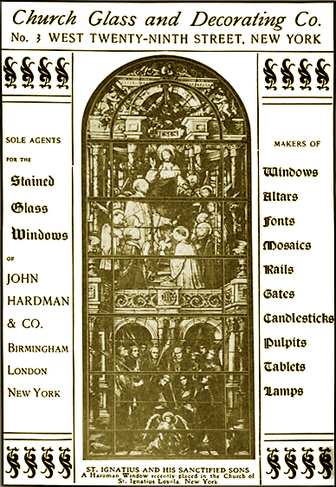
«Made in England»
By choice or because there was very few stained glass workshops before 1900, several Anglican churches have their windows imported from England. We thus find in Quebec stained glass windows from english artisans of great reputation that provide a nice diversification to our heritage of stained glass.
 |
Serge Rodrigue |
John Hardman (1767-1844): he was the patriarch of the family business in Birmingham who was involved in metal works and stained glass windows until 2008. He provided windows for the building of Parliament in London... that he has rebuilt after World War II. Outside the United Kingdom, Hardman & Co delivered stained glass windows in Canada, the United States and Australia.
Thomas Ward (1808-1870), Henry Hughes (1822-1883): Ward started in stained glass business in 1836 with James Henry Nixon (1802-1857) in London. Their activities continued for twenty years until the death of Nixon. The new duo, Ward & Hughes has produced a large number of windows. After 1870, their design has evolved toward the aestheticism movement, giving their best works. The company was in operation after their death until 1920.
John Richard Clayton (1827-1913), Alfred Bell (1832-1895): they opened their business in 1855 in London. Demand was so strong throughout the Commonwealth that the company used factory production methods. At its peak in 1870, Clayton & Bell had 300 employees. With good means, the best glass and best designs were used. And it seems! Their stained glass windows have many details and brilliance. The company continued its activities until 1993.
 |
American Ecclesiastical Review, 1901 |
Sir Edward Coley Burne-Jones (1833-1898): self-taught painter and multi-disciplinary craftsman, he presented his paintings at the Grosvenor Gallery in London in 1877 where he is therefore recognized as a major figure in the aestheticism movement. He was associated with William Morris, a multi-disciplinary artist in decorative arts, to realize several windows. He was ennobled in 1894.
Henry Holiday (1839-1927): painter and illustrator, he was greatly influenced by Burne-Jones. He was designer of stained glass windows for James Powell & Sons. He left Powell in 1891 to open his own workshop. He drew more than 300 windows. Among them, there is a set in Westminster Abbey.
 |
Serge Rodrigue |
 |
Serge Rodrigue |
 |
Serge Rodrigue |
 |
Serge Rodrigue |
The window of the church Ste-Agnes, Lac Megantic
 |
This imposing window mounted using an elaborate structure, distinguishes itself at several levels. His illustration of The Tree of Jesse, an iconographic representation of the ancestors of Jesus is unique in Quebec. The window is the work of William Wailes, one of the most prolific stained glass workshops of England in early 19th century.
In 1914, Father Charles Roy in his Report of the visit of Archbishop Stagni (Laflamme & Proulx), described the beautiful window measuring "32 feet high by 20 feet wide" and "made in England 160 years ago."
The reality is a bit more modest: the window measures 26 by 16 feet and it was built in 1849. It was first installed in the Church of the Immaculate Conception in London. They replaced it with an another window in July 1912. John Hardman workshops were to dismantle and restore it.
After a long diplomatic work on the part of the priest Joseph-Eugene Choquette of Lac Megantic, it was granted to him. The Father Roy adds that Choquette "had the happiness to put it together himself in his Church in July 1913." One can believe it: the priest Choquette acted as physicist in his spare time tinkering microphone, telephone, dynamo, battery, lighting and photographic processes. He was dubbed as the Electrical Priest !